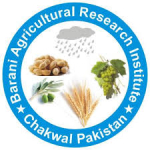CGIAR Research Program on Dryland Systems - DS
Leader Abdul Majid, International Center for Agricultural Research in the Dry Areas - ICARDA
Team
members: 10
Partner
organizations: 5
Budget 2025
USD :
0
Activities/Products: 8
Description
The Chakwal Site in Pakistan for CRP DS is a part of the Pothwar plateau which is the largest contiguous block of rain-fed areas of the Punjab, Pakistan . It covers an area of 1.82 million ha, and topography ranges from flat to gently undulating, locally broken by gullies and low hill ranges. The climate of Pothwar ranges from semi-arid to sub-humid, sub-tropical continental. The rainfall ranges from above 1500 mm in some northern hilly parts to 250 mm per annum and is very erratic. About 60-70 percent rainfall occurs during moon soon during monsoon i.e., mid-June to mid-September resulting in flash floods and causing erosion and soil loss.
Chakwal District is located between Rawalpindi, Attock, Mianwali, Khushab, and the Jehlum Districts. The total area of Chakwal district is 6,609 square kilometers with a population of 1,371,228. Chakwal is subdivided into 4 tehsils (Chakwal, Talagang, Choa Saidan Shah and Kallar Kahar). The annual growth rate of Chakwal is 1.99% and the population density is 210 persons per square kilometer. The majority of the population (86%) is residing in rural areas while the remaining (18%) is settled down in urban areas. The per capita income of Chakwal is $ 890 which is considerable lower than national average of $ 1386; literacy rate is 69% and the average household size is 6 people. The Chakwal District is basically an agricultural area with no significant industry and most of the people earn their livelihood through agriculture production. The erratic rainfall increase risk and vulnerability due to long drought and crop failures.
Two clusters one for resilience and one for intensification within Chawkal are selected for CRP DS integrated activities. Each cluster comprised of 10-12 small villages. The resilience cluster falls in low rainfall area (250-300 mm) and represents the larger cropping pattern of Wheat-Groundnut being practiced in most of the Pothwar area. Similarly the intensification cluster is representative for medium to high rainfall (600-900 mm) with a mix cropping system including wheat, groundnut, rapseed and mustard. Fodder crops including maize, millet, sorghum and oat are grown and mix livestock farming (cattle, buffalo, sheep, goat) prevails in both clusters. Small scale water availability for agriculture provides opportunities for intensification and improving resilience. Women participation in agriculture, particularly crops is high at both clusters.
Within Chalwal site the activities of CRP DS are being implemented and the presence of both provincial and federal R&D institutes provides opportunities for collaboration and integration of activities for up scaling the outcomes of the CRP DS in larger Pothwar Plateau. The potential for both resilience and intensification along with gender focused livelihood improvement options exists within the selected clusters and largely in the overall area for up scaling. Community organizations and NGOs are also working in the area and willing to collaborate for livelihood improvement through agricultural development. The target area is easily accessible for project activities for the collaborating partners and could be linked to different markets. Due to high population growth and low employment opportunities particularly for women there is high unemployment rate. The potential for engaging women and youth in agriculture exists subjected to availability and dissemination of technologies for profitable rainfed agriculture. In both cluster, the dominant agricultural livelihood system is agro-pastoral wherein livestock is an essential component as a source of livelihood, nutrition and insurance against all kinds of risks. Low input, subsistence crops and livestock farming have led to high productivity gaps and fewer opportunities for value addition due to limited surplus produce. The adoption of the viable options developed within CRP DS is likely to move fast due to increasing dependence on agriculture and fewer opportunities for employment in the area. ICARDA has developed a long term association and working relations with other local partners in this rainfed ecology. ICARDA has already introduced many improved technologies in on-going projects and developed working relationship with the communities throughout this region.
Furthermore the recent focus on exploiting the potential of rainfed ecologies by Government of Pakistan would help to develop effective partnership between ICARDA and public sector R&D development agencies and NGOs. The area is prone to higher level of poverty along with increasing vulnerability due to climate change. The integrated efforts through the CRP DS would help to achieve a more resilient integrated farming system through boosting productivity and diversification of livelihood options for resource poor farmers in the area. The efforts to integrate the capacity building and linking service providers would help to develop local capacity for supporting and adopting innovations and changed practices through CRD DS initiatives.
Atlas
Activities/Products
Projects
| Acronym | Project Title | Year | Section | Leader | Center | Budget | Start Date | End Date | View |
|---|
Outcomes and Impact
| Code | Outcomes and Impact | Type | Indicators | View | |
|---|---|---|---|---|---|
| 1 | Employment opportunities availability and access increased | development outcome | 0 | ||
| 2 | Female and male farmers/stakeholders (inc.youth) awareness, skills and knowledge increased | research outcome | 5 | ||
| 3 | Water use efficiency and Water Productivity increased | research outcome | 0 | ||
| 4 | Tools, methods, processes and capacity of stakeholders to create/customize resilience options improved | research outcome | 0 | ||
| 5 | Agroforestry practices adopted/incresed | research outcome | 2 | ||
| 6 | Crop yields increased | development outcome | 0 | ||
| 7 | Female and male farmers/shakeholders use/adopt/implement methods/tools/approaches/technologies/NRMpractices/Varieties/framework/concepts | research outcome | 2 | ||
| 8 | Fodder productivity increased | research outcome | 1 | ||
| 9 | Multi-stakeholder partnerships and interactive learning increased | research outcome | 1 |
Personnel Involved
Partners













